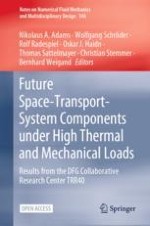For the mechanical analysis a standard static
Abaqus material model for linear elasticity with thermal expansion is used for the insulation. For the Incoloy a static elasto-viscoplastic material model with linear isotropic hardening and thermal expansion is implemented in an
Abaqus UMAT. A multiplicative split is used for the deformation gradient
\(\mathbf {F} = \mathbf {F}_e \, \mathbf {F}_p\).
\(\mathbf {F}_e\) represents the elastic part and
\(\mathbf {F}_p\) is the plastic part due to dislocation of the crystal grid. The constitutive equations are derived with the Clausius–Duhem inequality for isothermal processes
$$\begin{aligned} -\dot{\Psi }+ \varvec{\tau } \cdot \mathbf {d} \ge 0 \end{aligned}$$
(2)
Here,
\(\dot{\Psi }\) denotes the rate of the Helmholtz free energy,
\(\varvec{\tau }\) the Kirchhoff stress tensor,
\(\mathbf {d}\) the symmetric part of the velocity gradient
\(\mathbf {l} = \dot{\mathbf {F}} \mathbf {F}^{-1}\). The Helmholtz free energy
\(\Psi \) depends on the elastic Green-Lagrange strain tensor
\(\mathbf {E}_e\), on the accumulated plastic strain variable
\(\kappa \) and the temperature
\(\theta \). It is additively split into an elastic, an isotropic hardening and a thermal expansion part:
$$\begin{aligned} \Psi&= \Psi _{e}(\mathbf {E}_e) + \Psi _{iso}(\kappa ) + \Psi _{th}(\theta ) \nonumber \\&= \frac{\lambda }{2}[\text {tr}(\mathbf {E}_e)]^2 + \mu \,\text {tr}\, (\mathbf {E}_e^2) + H\kappa - \left( \theta - \theta _0 \right) \, \alpha _T \, \lambda \, \text {det}(\mathbf {F}) \end{aligned}$$
(3)
The elastic Green-Lagrange strain tensor is calculated by
\(\mathbf {E}_e = \frac{1}{2} (\mathbf {C}_e - \mathbf {I})\), whereas
\(\mathbf {C}_e\) is the right Cauchy–Green tensor and
\(\mathbf {I}\) the identity matrix.
\(\mu \) and
\(\lambda \) are the Lame constants given by the Young’s modulus and the Poisson’s ratio.
H is the hardening parameter and
\(\alpha _T\) the thermal expansion parameter. Inserting Eq. (
3) into the Clausius–Duhem equation (
2), the Kirchhoff stress tensor
\(\varvec{\tau }\) and the hardening variable
q are derived, c.f.
[
22]:
$$\begin{aligned} \varvec{\tau } = 2 \mathbf {F}_e \frac{\partial \Psi _e}{\partial \mathbf {C}_e} \mathbf {F}_e^T, \qquad q = -\frac{\partial \Psi }{\partial \kappa } \end{aligned}$$
(4)
The thermodynamical consistency is fulfilled with the evolution equations
$$\begin{aligned} \mathbf {d}_p = \dot{\lambda } \frac{\partial \Phi }{\partial \varvec{\tau }}, \qquad \dot{\kappa } = \dot{\lambda } \frac{\partial \Phi }{\partial q} \end{aligned}$$
(5)
Here,
\(\mathbf {d}_p\) is the symmetric part of the plastic velocity gradient
\(\mathbf {l}_p\) and
\(\Phi \) is the von-Mises yield surface
$$\begin{aligned} \Phi = || \text {dev} \varvec{\tau } || - \sqrt{\frac{2}{3}} (\tau _y - q) \end{aligned}$$
(6)
The plastic multiplier
$$\begin{aligned} \dot{\lambda } =\frac{ \bar{\Phi }}{\eta } \end{aligned}$$
(7)
completes the set of equations with the normalized yield function
\(\bar{\Phi }\).
\(\eta \) is the viscosity parameter, which controls the rate dependency of the material. The material model is modified for a plane stress state in order to also use it for shell elements. The structural model with the boundary conditions and element description is shown in Fig.
3. For the mechanical boundary conditions, the nodes at the circular clamping are fixed and the temperature distribution over the whole structure is given from the thermal analysis. The pressure of the fluid is given on the top surface. The three-dimensional mechanical model is composed of 43760 C3D8R and 2593 S4R elements with eleven integration points over the thickness. Mechanical material tests were conducted at the
Institute of Applied Mechanics to determine the Young’s modulus
E, the yield stress
\(\tau _y\) and the linear hardening parameter
H over a temperature range of 20–
\(1000\,^\circ \)C. The results can be found in Table
1. The Poisson’s ratio and the viscosity parameter are taken from
[
20].
Table 1
Temperature dependent material parameters for the mechanical analysis
20 | 197 | 220 | 662 |
100 | 191 | 209 | 685 |
200 | 185 | 178 | 714 |
300 | 178 | 150 | 731 |
400 | 170 | 127 | 748 |
500 | 165 | 110 | 766 |
600 | 158 | 112 | 706 |
700 | 150 | 114 | 601 |
800 | 139 | 109 | 300 |
900 | 134 | 100 | 45 |
1000 | 127 | 82 | 2 |
